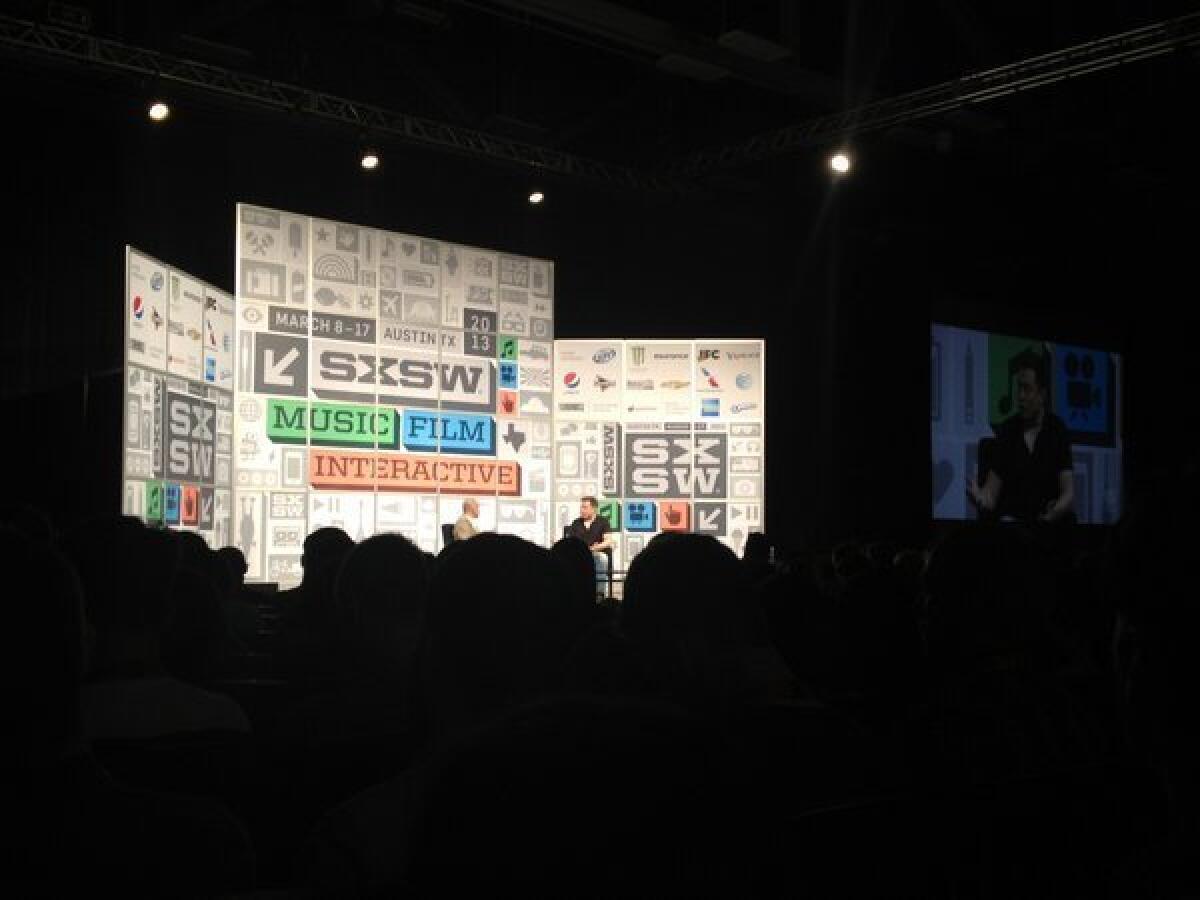SXSW: Elon Musk discusses hovering rocket, Mars and that NYT review

- Share via
AUSTIN -- Elon Musk says if mankind doesn’t make it to Mars by the time he dies, it’ll be the biggest disappointment of his life.
Speaking to a packed crowd of several thousand attendees at South by Southwest on Saturday, the founder of Tesla and SpaceX said he might even consider making the journey himself.
“I’d like to die on Mars, just not on impact,” he said.
For now, he’s been focusing his attention on something a bit closer to home. Musk revealed to the crowd that SpaceX is one step closer to developing a reusable rocket, saying the company recently launched a 10-story rocket that burst into the sky, rose 262.8 feet, hovered and landed safely on the pad 34 seconds later using thrust vector and throttle control. To cushion its fall back to the launch pad, the Grasshopper has steel landing legs with hydraulic dampers, plus a steel support structure.
PHOTOS: Private-sector space mission
Video of the test, which took place at SpaceX’s rocket development facility in McGregor, Texas, was shown to an enraptured South by Southwest crowd. Musk said it was the first time anyone aside from the video editor and himself had seen the footage, which you can check out below.
“It can land on Earth with the accuracy of a helicopter,” he said.
SpaceX, short for Space Exploration Technologies Corp., is trying to prove that the Grasshopper’s technology could be used to develop what would be the first-ever fully reusable rocket. A reusable system could mean big savings in developing and operating rockets. The closest example of a reusable launch system is the retired space shuttle fleet, which were only partially reused after a tedious months-long overhaul.
The latest Grasshopper test flight marks a significant increase over the height and length of hover of the Grasshopper’s previous test flights -- of 8.2 feet, 17.7 feet and 131 feet -- which took place last year.
Earlier this month, a SpaceX capsule successfully resupplied the International Space Station with cargo. The capsule is set to return to Earth on March 25, splashing down in the Pacific Ocean about 300 miles off the coast of Baja California.
Saturday’s hourlong keynote at the Austin Convention Center covered a wide variety of topics, including Musk’s thoughts on solar panels and higher education, battery cells, his role models (Benjamin Franklin, Steve Jobs, Jeff Bezos and Nikola Tesla) and his idea for a new mode of high-speed transportation dubbed the “hyperloop.”
“It would be something that would be twice as fast as a plane, at least, in terms of total transit time,” Musk said. “It would be immune to weather, incapable of crashing pretty much unless it was a terrorist attack, and the ticket price would be half of a plane.”
As for whether the hyperloop would run underground or above ground, Musk said, “it could be either.”
Musk also took the opportunity to reflect on last month’s highly publicized dispute with the New York Times, which published a review titled “Stalled out on Tesla’s Electric Highway,” in which reporter John Broder detailed a recent trip from suburban Washington, D.C., to Connecticut in a Model S. The goal was to test the feasibility of a road trip by using Tesla’s new Supercharging stations in Delaware and Connecticut.
Broder ran into difficulties with the car’s range, which were exacerbated by cold weather. After he left the car overnight without plugging it in, the Model S ended the trip on the back of a flatbed truck.
The New York Times published the story on a Sunday. After Tesla’s stock dipped the next day, Musk went on the offensive. Through Twitter and several television appearances, he railed against the piece, calling it “fake” and telling CNBC, “We think the article is something of a setup, and it’s pretty unreasonable.”
Musk released the data logs from Broder’s car several days later, saying they backed up his claims.
The New York Times initially responded by saying the article was “completely factual,” and Broder wrote a follow-up piece defending his initial assertions. The Times’ public editor, Margaret Sullivan, eventually waded into the controversy with a blog post that offered measured criticism of Broder but defended his motives.
Calling Broder’s review a “low-grade ethics violation” on Saturday, Musk said that the reporter wasn’t as bad as Jayson Blair, but that his review “was not in good faith.”
“I don’t have a problem with critical reviews, I have a problem with false reviews,” he said.
The one somewhat controversial moment came when moderator Chris Anderson asked Musk about his personal life, which Musk conceded was too busy, and his five children.
“Kids are awesome, you guys should all have kids. Kids are great,” Musk said, before revealing that he doesn’t see his children enough and often emails for work when he spends time with them.
“In the absence of that, I would not be able to get my job done,” he said, drawing mutters from the crowd.
Perhaps sensing the audience’s discomfort, Anderson said, “It’s really not good for the children, it’s really not good for the email.”
Musk’s response: “I do have a nanny there, otherwise they’d kill each other.”
ALSO:
SXSW: What ‘like’ button? Share what you hate with Hater app
Tesla posts revenue of $306 million and worse-than-expected loss
SpaceX: Spacecraft crippled, but Musk voices optimism it will recover
More to Read
Inside the business of entertainment
The Wide Shot brings you news, analysis and insights on everything from streaming wars to production — and what it all means for the future.
You may occasionally receive promotional content from the Los Angeles Times.










